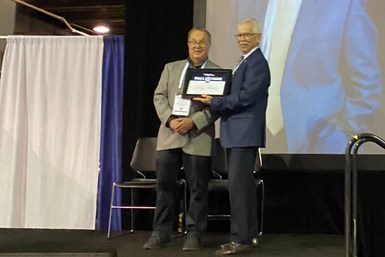Building Momentum for the Future of the Finishing Industry
Products Finishing editor-in-chief Scott Francis offers a quick recap of this year’s SUR/FIN surface finishing industry trade show.

A sense of collaboration and innovation was palpable at SUR/FIN 2022.
Photo Credit: All photos by Products Finishing
In some ways, the National Association for Surface Finishing (NASF) SUR/FIN 2022 trade show seemed to come quickly. The previous year’s finishing industry event had to be postponed from its usual summer timing to November due to COVID. However, having a chance to resume conversations from November seems to have built momentum for the surface finishing community at a time when it is definitely welcome.
The past few years have brought numerous issues to the surface that remain topics of conversation amongst finishers — supply chain woes, material price increases, the burden of increasingly strict regulations, difficulty finding skilled workers and retaining them. This year’s SUR/FIN had its share of such conversations. However, in spite of the challenges facing the finishing industry — and the manufacturing industry in general — the overall mood at SUR/FIN was incredibly positive. A sense of collaboration and innovation was palpable at the show in so many ways from the programming to the buzz on the show floor — I found I couldn’t walk more than a few steps without finding myself in a great conversation.

Judy Runge discusses electrochemical polarization and natural order as inspiration for surface finishing innovation.
The keynotes at SUR/FIN were focused on finding solutions and pushing innovation forward. Kim Tress, materials engineer for Stellantis responsible for functional coatings, discussed the role of coatings in addressing automotive industry trends such as electrification, autonomous vehicles, connectivity, sustainability and lightweighting. Judy Runge, Senior SME, Principle Engineer at Apple, spoke about looking to patterns in nature as inspiration for surface engineering. Inventor and tech strategist Julie Holmes spoke about the ways the world changed in the face of a global pandemic and offered proactive strategies for rethinking the way we approach business.

Finishing industry experts are offering a coordinated response to increasingly stringent regulations.
One highlight of this year’s SUR/FIN was a panel on “Transitioning Hexavalent Chromium and PFAS for Plating in the Automotive Supply Chain.” The discussion included perspectives from the USEPA, chemical suppliers, finishers, automotive OEMs and the NASF — all working together to address the changes that new legislation involving the use of hexavalent chromium and fume suppressants will bring to the finishing industry. The panel was a great example of the kind of proactive work that the finishing industry is undertaking to address the hurdles that it faces.

Tony Revier of Uyemura (right) is inducted into Products Finishing’s Finishing Hall of Fame.
There were numerous celebrations at SUR/FIN that underlined this sense of optimism. The NASF presented Milt Stevenson Junior of Anoplate the Silvio C. Taormina Award for his service to the finishing industry and also announced honorees for its 2022 Award of Merit awards. Award of Merit honorees included Jon Kilbarger (Dynapower), Kevin Pludeman (Cornerstone Systems) Stephanie Witt (Advanced Plating Technologies), and Steffen Wolkerstorfer (Wolkerstorfer Company).
Products Finishing also hosted awards at SUR/FIN, celebrating its 2022 Finishing Hall of Fame inductees Tony Revier (Uyemura) and Tom Richards (Process Technology). In addition, the 2022 qualifying electroplating and anodizing shops from the Top Shops Benchmarking Survey were unveiled, and this year’s 40-Under-40 class of emerging leaders in the finishing industry were recognized.
From a personal standpoint, this year’s SUR/FIN reinforced some of the conversations that I’ve had with folks in the industry. As we all watch the trends in manufacturing — from automotive trends to implementing Industry 4.0 solutions — and try to forecast where business is headed, I’m encouraged by the fact that a show like SUR/FIN fosters collaborative interactions between colleagues and even competitors for the good of the industry as a whole.
Related Content
Finishing Another Year — Looking Back at the Trends of 2023
Products Finishing reflects on a year of reporting on the surface finishing industry and looks ahead to what may be in store for 2024.
Read MoreThe Role of Surface Finishing in Modern Manufacturing: Trends and Best Practices
The entire manufacturing process for any part can benefit from considering the final finish early in the process. This article discusses trends in surface finishing with the goal of facilitating better communication with potential partners.
Read MoreENC 2025: Forwarding Electroless Nickel Innovation
The third installment of PF’s Electroless Nickel Conference set a new benchmark with record attendance, cutting-edge education and vital industry insights, reinforcing its role as a networking hub for the EN plating community.
Read MoreSpringing Forward With Industry Events
From Powder Coating Week insights to SUR/FIN opportunities, Products Finishing celebrates industry progress, people and the technologies shaping our future.
Read MoreRead Next
Delivering Increased Benefits to Greenhouse Films
Baystar's Borstar technology is helping customers deliver better, more reliable production methods to greenhouse agriculture.
Read MoreReducing Material Use and Overspray
Looking for applicators or process improvements for reducing material use and overspray? Binks offers helpful advice for searching out new solutions.
Read MoreAlkaline Cleaning Guide
Gregg Sanko, Senior Chemist, Oakite Products, Inc. provides an overview of the alkaline cleaning process.
Read More






















